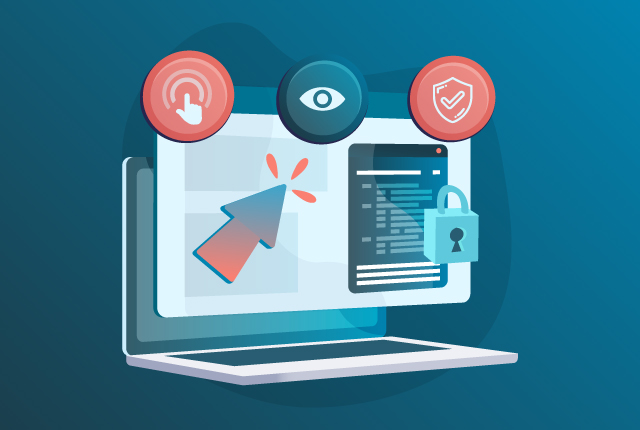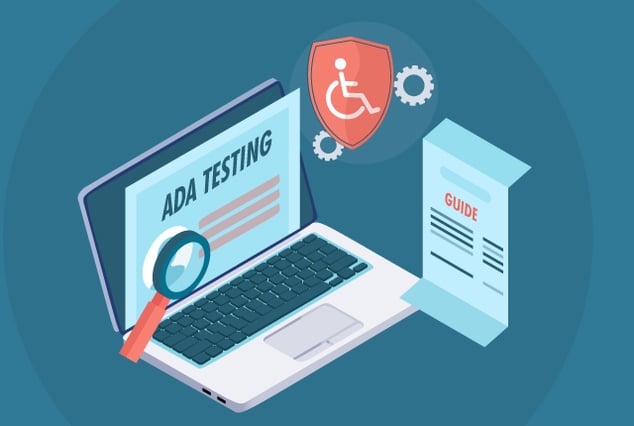
Table Of Contents
- What is QA accessibility testing?
- Why is accessibility testing crucial in 2025?
- Digital accessibility rules and regulations
- What should accessibility testing address?
- What are the types of accessibility testing?
- Top accessibility testing tools
- Integrating accessibility testing into your workflow
- Accessibility as a Service
- Common accessibility issues and how QASource addresses them
- How can QASource help with QA accessibility testing services?
- The latest AI trends in accessibility testing in 2025
- Conclusion
According to the World Health Organization, approximately 1.3 billion people, or 16% of the global population, experience significant disabilities. These disabilities can range from visual and auditory impairments to cognitive and motor challenges, affecting how individuals interact with digital content.
That is why a massive group often struggles to access digital content due to poor design and a lack of accessibility measures. Common issues include low-contrast text, missing alternative text for images, and unlabeled form inputs, which can hinder usability for people with disabilities. However, accessibility testing plays a crucial role in identifying and addressing these barriers, ensuring that web applications are usable by everyone, regardless of their abilities.
In this blog, we'll explore the latest trends in accessibility testing, the challenges faced by customers, and the solutions provided by QASource.
What Is QA Accessibility Testing?
QA accessibility testing is a quality assurance process that verifies whether digital content like websites, mobile apps, and software is usable by people with various disabilities. It ensures that users with vision, hearing, mobility, or cognition impairments can access, navigate, and interact with digital interfaces effectively. It is performed to ensure that the product meets various accessibility standards like WCAG(Web Content Accessibility Guidelines) and Section 508 (U.S. federal accessibility requirement)
Unlike general QA, which focuses on functionality, performance, and security, accessibility testing specifically targets usability for assistive technologies such as:
- Screen readers (e.g., JAWS, NVDA)
- Keyboard-only navigation
- Voice recognition software
- Braille terminals
Key Objectives of QA Accessibility Testing
- Compliance with standards like WCAG 2.1/2.2, Section 508, ADA (Americans with Disabilities Act)
- Inclusive design for all users, regardless of disabilities
- Detection of barriers such as poor contrast, missing alt text, and inaccessible form fields
- Avoid potential lawsuits due to non-compliance with accessibility laws.
- Make accessibility a continuous part of the software development lifecycle
- Verification of compatibility with assistive technologies
Why is Accessibility Testing Crucial in 2025?
In 2025, accessibility testing will become a core requirement for digital products. It’s no longer a “nice-to-have”; it’s essential for compliance, usability, and business success.
-
Legal Compliance Is Non-Negotiable
Laws now mandate accessible digital experiences. The ADA applies to websites and apps. In 2023, there were over 4,600 accessibility lawsuits in the U.S. alone (UsableNet). Europe and other regions have similar laws. Non-compliance can lead to fines and reputational damage.
-
Everyone Deserves Equal Access
Digital services must work for all users. That includes people with vision, hearing, mobility, or cognitive challenges. Accessibility testing helps identify and fix barriers. It ensures that no one is left out.
-
Accessibility Improves User Experience
Good accessibility supports all users. It helps people with temporary injuries, older adults, and those on slow connections. Simple features like readable fonts and clear navigation benefit everyone. These improvements also enhance SEO and site performance.
-
AI and Automation Boost Efficiency
AI tools are changing how teams test. They simulate users, scan for WCAG issues, and suggest fixes. This speeds up testing and reduces manual work. It also helps catch issues earlier in the development cycle.
-
Integral part of Quality Assurance
Accessibility is now part of standard QA. For example, teams must test for usability when checking for bugs or performance. Accessible products are more reliable, usable, and inclusive.
Digital Accessibility Rules and Regulations
Accessibility testing isn't just a nice-to-have best practice—it's the law. The government is on the side of the people in ensuring that all technologies, including web-based and mobile applications, are accessible to all.
- Americans with Disabilities Act Section III: This law requires that all domains, such as schools, organizations, and public buildings, be accessible to everyone, including web-based applications and technology.
- Title II of the ADA: This law enforces that all programs, services, and activities provided by state and/or local governments are accessible to everyone, including web-based applications and technology.
- Sections 504 and 508 of the Rehabilitation Act of 1973: Section 504 requires that reasonable accommodations be available for people with disabilities within the workplace, educational institutions, and organizations. Section 508 establishes requirements to be met by these institutions so that technology is accessible to everyone.
Web Content Accessibility Guidelines (WCAG): These protocols provide accessibility testing examples and recommend types of accessibility testing so that development and QA teams can discover ways to improve application accessibility. WCAG recommends the following four main principles:
- Perceivable: All users can comprehend all displayed information being depicted, including how to use the application's user interface.
- Operable: All users can navigate all interface components without issues or barriers.
- Understandable: All users can understand all displayed information being presented, including how to navigate through the user interface of an application.
- Robust: All users can reliably interpret content within an application through assistive technologies.
What Should Accessibility Testing Address?
Knowing how to do accessibility testing starts by examining the types of disabilities that require enhanced support throughout your application. Your accessibility test cases should confirm that your product can provide a seamless experience for everyone, including those with the following disabilities:
- Vision: Difficulty watching videos or reading text due to complete blindness, color blindness, or vision impairment
- Hearing: Difficulty hearing verbal communication or digital media due to deafness or hearing impairment.
- Mobility: Difficulty with physical movement, including using physical technology requirements like a keyboard or mouse.
- Cognitive: Difficulty remembering, concentrating, or making decisions.
What are the Types of Accessibility Testing?
You can break down your approach to performing accessibility testing into two categories: Manual Testing and Automated Testing. Like many forms of QA testing, a strong accessibility testing strategy should apply both testing approaches for full testing coverage.
Approaches to Accessibility Testing
- Manual Testing: QA testers should manually test any test case that requires physical interaction with the application and the usability of the user interface across potential barriers. Accessibility testing examples include manually reviewing keyboard accessibility, UI structural elements, style disablement, content scaling, and text sizing. These types of tests can also rely on the assistance of accessibility testing tools to increase accuracy and efficiency during the testing process.
- Automated Testing: QA teams can further expedite the testing process for accessibility with automated testing tools designed to catch errors across hundreds of web pages. Automated testing is ideal for analyzing image contrast, design styling, and application functionality, which often can't be manually tested.
Types of Accessibility Testing
- Functional Testing: Evaluates core functionality to ensure operability using assistive technologies.
- Usability Testing: Focuses on the overall user experience, involving disabled testers for feedback.
- Manual Testing: Human testers use assistive technology to identify accessibility issues.
- Automated Testing: Tools check for common accessibility issues quickly.
- Compatibility Testing: Checks performance across browsers, devices, and assistive technology.
- Mobile Accessibility Testing: Evaluates mobile apps and websites for mobile devices.
- Cross-browser Testing: Ensures accessibility across various web browsers.
- Cross-Platform Testing: Evaluates accessibility across different operating systems and devices.
- Content Testing: Focuses on the accessibility of text, images, and multimedia.
- Compatibility with Assistive Technologies: Ensures compatibility with various assistive technologies.
- Regression Testing: Re-tests accessibility after updates or changes.
Top Accessibility Testing Tools
- Wave
- Tenon
- Axe
- JAWS
- Accessibility Valet
Integrating Accessibility Testing into Your Workflow
Accessibility testing services are becoming more common nowadays, where Organizations hire external experts to perform audits, provide guidance, and ensure ongoing accessibility compliance. It is a model that offers accessibility-related tools, resources, and expertise to organizations on a subscription or on-demand basis.
- It can scale to meet the specific needs of an organization. Organizations can adjust their subscription or service level for a small project or a large-scale initiative.
- Its providers often have accessibility experts who can offer guidance, training, and support. This expertise can help organizations navigate complex accessibility standards and ensure compliance with regulations like WCAG (Web Content Accessibility Guidelines).
- AaaS typically includes access to a suite of accessibility testing and auditing tools. These tools can automatically scan websites, applications, and digital content to identify accessibility issues, helping organizations identify and fix problems efficiently.
- It often provides detailed reports and analytics on accessibility performance, making it easier for organizations to track progress and prioritize areas for improvement.
- It can be customized to fit the specific needs of different industries and sectors, including web development, e-commerce, education, and government. This flexibility ensures that accessibility solutions align with an organization's unique requirements.
- AaaS often includes training materials and resources to help organizations educate their teams on accessibility best practices. This can lead to improved awareness and a culture of accessibility within the organization.
Accessibility as a Service
Below are a few benefits of implementing Accessibility as a Service:
-
User-Centered Testing
Including individuals with disabilities in the testing process remains a critical aspect of accessibility testing because it ensures that digital products and services are evaluated from the perspective of individuals with disabilities, the primary users. Their feedback provides insights into real-world user experiences and helps identify issues that might not be caught through automated testing alone.
This approach is essential for several reasons:
- Involves individuals with disabilities who use assistive technologies and have firsthand experience navigating the digital environment. Their feedback is invaluable in identifying real-world accessibility barriers and understanding users' challenges.
- Ultimately, the goal of accessibility is to provide an enjoyable and effective user experience for individuals with disabilities. By involving these users in testing, you can gather insights into their preferences, pain points, and satisfaction levels, leading to more user-friendly designs.
- User feedback can help prioritize accessibility issues based on their impact on real users. This ensures that critical issues are addressed first, improving the overall accessibility of the product.
- Adapt to the needs and preferences of individual testers. This flexibility allows testers to use their preferred assistive technologies and settings, ensuring a more accurate accessibility assessment.
- Replicate the real-life situations in which individuals with disabilities use digital products. Testers can assess how well the product performs in context, such as completing tasks or accessing information.
- Many countries have laws and regulations that require digital products to be accessible. User-centered testing helps organizations demonstrate their commitment to accessibility and compliance with these laws.
-
Mobile Accessibility Testing
With the continued growth in mobile app usage, accessibility testing for mobile platforms, including iOS and Android, remains a top priority. Mobile accessibility testing tools and techniques have evolved to address unique challenges.
-
Cross-Platform Testing
Ensuring digital content is accessible across various platforms, including desktop, mobile, and emerging technologies, is a key trend. Testing across different devices, operating systems, and screen sizes is essential.
-
CI/CD Integration
Integrating accessibility testing into the CI/CD pipeline helps identify and address accessibility issues early in development, reducing remediation costs and time.
-
Voice User Interface (VUI) Testing
With the increasing prevalence of voice-activated devices and applications, accessibility testing for voice interactions and VUIs has become crucial. Voice User Interface (VUI) testing is critical to accessibility testing, especially for applications and devices that rely on voice commands and interactions. VUI testing ensures that individuals with disabilities, including those with limited mobility, visual impairments, or speech impairments, can effectively use voice-based interfaces.
Common Accessibility Issues and How QASource Addresses Them
Challenge 1
A prominent client in the eLearning industry faced a challenge during the regular development of their application with new features. As the application was being updated regularly, the Accessibility testing conducted according to the latest WCAG guidelines revealed many Accessibility Bugs. These bugs needed to be addressed before the application could go live with the new features, causing delays in the product's release cycle.
Solution
Our dedicated and experienced onshore team thoroughly investigated the root cause of the high defect percentage in Accessibility testing. We advised the client's development team to adopt best practices from the beginning of the development phase. Specifically, we recommended assigning unique IDs to each interactive element and ensuring all required attributes are added to the interactive fields. This proactive approach led to a substantial improvement, reducing the defect percentage from 80% to nearly 20%. The client was highly satisfied with this approach, as it significantly enhanced the application's accessibility and streamlined the release process.
Challenge 2
The customer in the e-learning domain faced the challenge of integrating accessibility testing seamlessly into their rapid release cycle. They released products weekly with new enhancements, ensuring that accessibility compliance was crucial. However, conducting accessibility testing manually for each release was time-consuming and could cause delays in the release process.
Solution
To address this challenge, we collaborated with our in-house DevOps team and the accessibility testers to automate the sanity test cases for accessibility. We integrated these automated tests with the customer's build management system. Now, whenever a new build was deployed, the automated suite for accessibility testing would run automatically. This streamlined process allowed real-time detection of accessibility issues, enabling the prompt fixing of any problems surfaced. The automated suite generated intuitive reports to stakeholders, facilitating informed and timely decision-making regarding the product's accessibility compliance. This approach ensured accessibility testing became an integral and automated part of their build management process, reducing the potential for accessibility issues to impact product release.
Challenge 3
The client faced the challenge of certifying many eBooks (100+) within a tight timeframe of one week. Each eBook was substantial in size, ranging from 500 to 1000 pages. Manual accessibility testing for such a volume and size would be extremely time-consuming and impractical within the given timeframe.
Solution
Our expert accessibility testers thoroughly studied the client's requirements and identified automated tools that could rapidly and accurately perform accessibility testing of eBooks. We proposed a comprehensive testing plan and approach to the client, outlining how the computerized tools would ensure a quick and accurate accessibility assessment across all the eBooks. We provided estimates for the testing effort.
The client was pleased with our proactive approach, strategy, and commitment to quality. They agreed to the proposed solution, and our team tested and certified all the eBooks within the stipulated one-week timeframe. The successful completion of this project impressed the client, leading to the signing of a contract for a dedicated accessibility team, indicating their confidence in our abilities to meet their ongoing accessibility testing needs.
How Can QASource Help With QA Accessibility Testing Services?
Businesses can benefit from QASource in several different ways, including:
- Comprehensive Testing: QASource offers a wide range of QA testing services, covering functional, non-functional, security, usability, and accessibility aspects to ensure thorough testing coverage.
- Customized Solutions: We tailor testing strategies to fit specific project requirements, whether integrating testing into DevOps, managing dedicated testing teams, or addressing unique challenges.
- Efficiency through Automation: We employ automation to speed up testing processes, improve accuracy, and increase test coverage, reducing time-to-market.
- Quality Assurance: Our expertise ensures software reliability, functionality, and industry compliance.
- Risk Mitigation: By identifying and addressing issues early, QASource helps mitigate risks, reduce development costs, and enhance product quality.
- User-Centered Approach: QASource focuses on user satisfaction by conducting usability and accessibility testing, ensuring a positive user experience.
- Continuous Improvement: We support continuous improvement through feedback, reporting, and ongoing optimization of testing processes.
Overall, QASource is a trusted partner for enhancing software quality and delivering reliable, user-friendly products.
The Latest AI Trends in Accessibility Testing in 2025
Accessibility testing is smarter, faster, and more essential than ever. New technologies and stricter laws are pushing teams to rethink how they test for inclusivity. Here are the key trends shaping the field:
-
AI Is Leading the Way
AI tools now detect more than 70% of common accessibility issues. They offer instant feedback during development. This reduces manual testing and speeds up release cycles. Tools like Axe-Core AI and Microsoft’s AI extensions are widely used.
-
Shift-Left Testing Is Standard
Accessibility checks now begin early, during design and coding. This is called “shift-left testing.” It helps catch problems before they grow. Teams embed accessibility into every sprint and pull request.
-
More Personalization Features
Websites now adapt to user needs automatically. Users can adjust font sizes, contrast, and navigation modes. These features help people with visual, cognitive, or motor impairments use content more comfortably.
-
Stricter Global Laws
New laws are changing how companies build digital products. The European Accessibility Act comes into full effect in June 2025. It requires websites, apps, and devices to meet accessibility standards. Non-compliance can lead to penalties.
-
Accessibility Is a Business Focus
Companies now treat accessibility as a core part of user experience. It’s not just about compliance; it’s about reaching more users. Accessible products gain trust, improve usability, and grow brand value.
Conclusion
At QASource, we understand the power of inclusivity in shaping digital experiences. Our dedicated team of accessibility testers is well-versed in the latest industry standards and best practices. We employ a combination of Automated tools, Manual Testing, and real-user feedback to ensure that your products meet the highest accessibility standards, allowing you to connect with a diverse audience and enhance your user experience. Contact us today to learn more about how our accessibility testing services can elevate your business.


